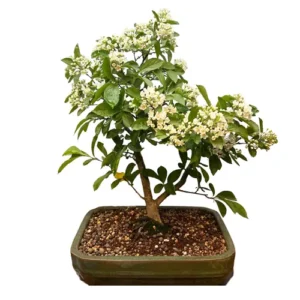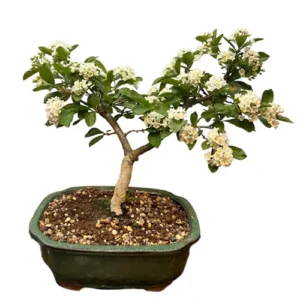Chamaecyparis obtusa
Hinoki Cypress Bonsai
These hardy evergreen species are native to Japan and famed for their lush bright green foliage. Its flat, fan-shaped branches decorate a tree adorned in vibrant reddish-brown bark. Typically Hinoki Cypress grow in a formal upright fashion making them a statly presence in any space.
Hinoki Cypress Bonsai Care Tips
Placement
Hinoki Cypress is a pretty hardy outdoor bonsai and can take full sun, only needing slight shade in the summer. It may be worth protecting this species from potentially drying winds. If you expect temperatures below -5 °C in the cooler seasons, consider moving it to an unheated greenhouse, conservatory, or providing insulation for the pot.
Watering
Hinoki Cypress requires watering on a daily basis from late spring to the arrival of autumn. One of the best ways to keep the plant satisfied is by using a mister to spray the leaves, as well as placing a gravel tray under the pot to create a more humid microclimate around the tree and reduce evaporation from the leaves. Be absolutely sure to keep the soil moist at all times.
Feeding & Fertilising
It is generally advised that the Hinoki Cypress is fed fortnightly from early spring through to the middle of autumn. You may wish to start your feeding with a higher nitrogen fertiliser at the start of spring moving to a regular fertiliser in the summer.
Pruning & Wiring
New shoots and tips can be pinched out two to three times across the growing season. Secondary branches should be pruned back in the spring or summer.
Wiring a Hinoki Cypress is best done in the spring or mid-summer. One needs to take care not to trap any of the conifer foliage under the wire. Replace wires whenever necessary and do not leave in place longer than 10 months. We also recommend using wires with a thickness that matches the thickness of the branch: if the wire you choose is too thick you will damage the bark. If it is too thin, it won’t be effective.
Repotting
Hinoki Cypress demands repotting every other year in mid-spring for the first 10 years of its life. After 10 years it is on a when necessary basis. Akadama soil is advised for these evergreen species.
Trees that are ready for repotting will require root pruning, a suitable new pot and appropriate soil mix.
When repotting, do not cut back the root mass by a large amount, and choose a well-draining soil mix that has a neutral or slightly higher PH value of 5-6 but not over 7. We tend to use a mixture of different speciality bonsai soils on our trees. Every species is different so please contact us for free soil-mix advice or to take advantage of our repotting service.
Bonsai trees aren’t only magnificent additions to an indoor oasis, they are more than capable of standing out in any garden. Many Bonsai species are incredibly hardy and withstand nature’s colder and damper turns with aplomb making them worthwhile outdoor plants. We have an extensive library of care guides for outdoor bonsai trees. It’s not about selecting the perfect bonsai, it’s about selecting the perfect bonsai for you.
Hinoki Cypress Bonsai - Typical Queries
How to propagate Hinoki Cypress Bonsai?
Hinoki Cypress can be propagated from seeds, cuttings and layering. For seed propagation, they will need treating prior with cold and can take around a year to show growth. For cutting propagation, use softwood that should be taken at the end of summer. Air layering is also an option, but can be challenging with this species.
Do Hinoki Cypress get pests and diseases?
Hinoki Cypress is a species that will stay reliably healthy with the correct care. Pests that can occur are spider mites, scale and wood boring beetles, which are particularly troublesome. Specific pesticides should take care of these. Tip blight can also occur, use a special fungicide in this circumstance.
Can you keep a Hinoki Cypress bonsai indoors?
Requiring full sun during the growing season and plenty of light across the winter this hardy evergreen is not to be grown indoors. Keeping indoors will likely hamper growth and health.





















